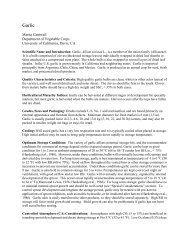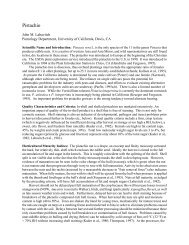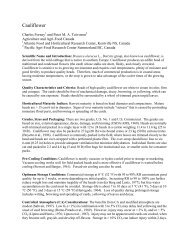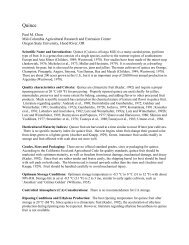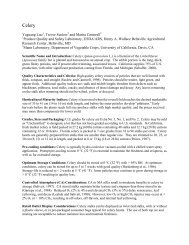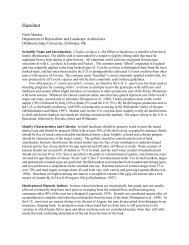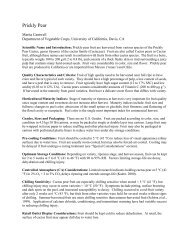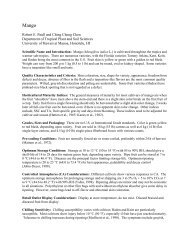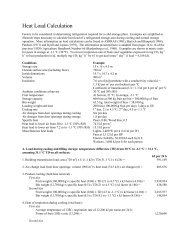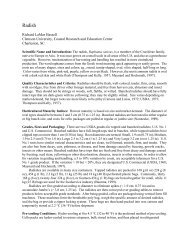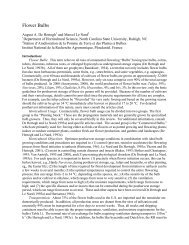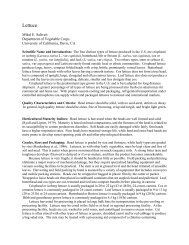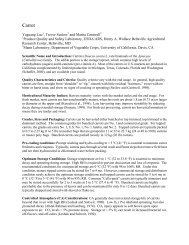Eggplant
Eggplant
Eggplant
You also want an ePaper? Increase the reach of your titles
YUMPU automatically turns print PDFs into web optimized ePapers that Google loves.
<strong>Eggplant</strong><br />
Jorge H. Siller-Cepeda<br />
Postharvest Physiology and Technology Laboratory, CIAD, Culiacán, Carretera a El Dorado,<br />
Culiacán, Sinaloa, Mexico<br />
Scientific Name and Introduction: The eggplant (Solanum melongena L.) is an annual plant of the<br />
Solanaceae or nightshade family. The edible portion is the immature fleshy pulp of the fruit. The fruit may<br />
be oval, round, long or pear shaped; the skin is smooth and shiny. The color may be black and purple,<br />
yellow, white or striped. The main types include Standard (American), Japanese, Italian, Philippine, Thai,<br />
and Chinese. <strong>Eggplant</strong>s are primarily grown in Mexico, Florida, New Jersey, Dominican Republic and<br />
Jamaica and are available year-round.<br />
Quality Characteristics and Criteria: A high quality American eggplant is uniformly egg to globular<br />
shaped, has a fresh green calyx, firm flesh and a dark purple skin. Additional quality indices are size,<br />
freedom from growth or handling defects and decay. Characteristics of other eggplant types include<br />
Japanese (elongated, slender, light to dark purple; very perishable), White (small egg shaped to globular;<br />
thin skinned), Mini-Japanese (small elongate, striated purple; violet), Chinese (elongated, slender, light<br />
purple); and Thai (small, round striated dark green).<br />
Horticultural Maturity Indices: <strong>Eggplant</strong> fruits are harvested at a range of developmental stages.<br />
Depending on cultivar and temperature, the time from flowering to harvest may be 10 to 40 days. Generally<br />
fruits are harvested immature before seeds begin to significantly enlarge and harden. Firmness and external<br />
glossiness are also indicators of a pre-maturity condition. <strong>Eggplant</strong> fruit become pithy and bitter as they<br />
reach an overmature condition.<br />
Grades, Sizes and Packing: Grades include Fancy, U.S. No. 1, U.S. No. 2, and Unclassified. Distinction<br />
among grades is based solely on size, external appearances, and firmness. Sizes are defined as: Small, 32<br />
fruit/box with fruit length 12 to 14 cm (4.75 to 5.5 in); Medium, 24 fruit/box with fruit length 19 to 21 cm<br />
(7.5 to 8.25 in); Large, 18 fruit/box with fruit length 21 to 24 cm (8.25 to 9.5 in); and Extra Large, 16<br />
fruit/box with fruit length 24 to 26 cm (9.5 to 10.25 in) (Siller et al., 1995). Packages commonly are<br />
one-piece waxed fiberboard boxes or wire-bound crates, 0.39 m 3 containing 15 kg (33 lb). Fruit are<br />
individually wrapped with paper.<br />
Pre-cooling conditions: Rapid cooling to 10 °C (50 °F) immediately after harvest is necessary to retard<br />
discoloration, weight loss, drying of calyx, and decay (Ryall and Lipton, 1979). Hydro-cooling and<br />
forced-air cooling are most effective, but room-cooling after washing or hydro-cooling is common.<br />
Optimum Storage Conditions: Fruit are stored at 10 to 12 °C (50 to 53.6 °F) with 90 to 95% RH (Ryall<br />
and Lipton, 1979). Storage of eggplant is generally less than 14 days as visual and sensory qualities<br />
deteriorate rapidly. Decay is likely to increase after storage > 2 weeks, especially after removal to typical<br />
retail conditions. Short-term storage or transit temperatures below this range are often used to reduce weight<br />
loss, but result in chilling injury after transfer to retail conditions.<br />
Controlled Atmosphere (CA) Considerations: CA storage or shipping offers little benefit to eggplant<br />
quality maintenance. Low O 2 levels (3 to 5%) delay deterioration and the onset of decay only a few days.<br />
<strong>Eggplant</strong> tolerates up to 10% CO 2 but storage-life is not extended beyond that under reduced O 2 . Wrapping<br />
fruits with plastic film to create modified atmosphere reduces weight loss and maintains firmness, due to the<br />
high RH, especially on Japanese eggplant types, which have a high transpiration rate (Díaz Pérez, 1998a).
Wrapped eggplant fruit in high density polyethylene (HDPE) maintain a fresher flavor, firmness and quality<br />
for a longer period (Ben-Yehoshua et al., 1985; Díaz Pérez, 1998b).<br />
Retail Outlet Display Considerations: <strong>Eggplant</strong>s should never be held in contact with ice. Odor from<br />
ginger, and possibly other odor producing commodities like onions, is absorbed by eggplants. So, these<br />
products should not be placed in close proximity (Sargent, 1998).<br />
Chilling Sensitivity: <strong>Eggplant</strong>s will develop chilling injury after storage for 6 to 8 days at 5 °C (41 °F).<br />
Surface pitting and scald are definite external symptoms (McColloch, 1966). Scald refers to brown spots or<br />
areas that are first flush with the surface, but may become sunken with the time. Browning of the flesh and<br />
seeds are conspicuous internal symptoms of chilling injury, almost invariably followed by decay caused by<br />
Alternaria sp. (Ryan and Lipton, 1979). Chilling injury is cumulative and may be initiated in the field prior<br />
to harvest. Symptom development can be reduced by storage in polyethylene bags or polymeric film<br />
overwraps, however, increased decay from Botrytis is a potential risk.<br />
Temperature American Japanese Chinese<br />
(days to visible chilling symptoms)<br />
0.0 °C 1 to 2 2 to 3<br />
2.5 °C 4 to 5 5 to 6 5 to 6<br />
5.0 °C 6 to 7 8 to 9 10 to 12<br />
7.5 °C 12 12 to 14 15 to 16<br />
Ethylene Production and Sensitivity: Rates of ethylene production vary from 0.1 to 0.7 µL kg -1 h -1 at 12.5<br />
°C (54.5 °F). <strong>Eggplant</strong> fruit have a moderate to high sensitivity to exogenous ethylene. Calyx abscission<br />
and increased deterioration, particularly browning, may be a problem if eggplant are exposed to > 1 µL L -1<br />
ethylene during distribution and short-term storage.<br />
Respiration Rates:<br />
Temperature American White egg Japanese<br />
(mg CO 2 kg -1 h -1 )<br />
12.5 °C 60 to 78 104 to 122 124 to 138<br />
To get mL kg -1 h -1 , divide the mg kg -1 h -1 rate by 2.0 at 0 °C (32 °F), 1.9 at 10 °C (50 °F), and 1.8 at 20 °C<br />
(68 °F). To calculate heat production, multiply mg kg -1 h -1 by 220 to get BTU per ton per day or by 61 to<br />
get kcal per metric ton per day. Data from Cantwell and Suslow, 1998.<br />
Physiological Disorders: No significant disorders at this time.<br />
Freezing Injury: Depending on the soluble solids content, fruit freeze at - 0.8 °C (30.6 °F). Symptoms<br />
include water-soaked pulp that becomes brown and desiccated over time.<br />
Physical Injury: Harvesting should be done by cutting the calyx-stem free from the plant rather than by<br />
tearing. Cotton gloves are often used to protect the fruit. Bruising and compression injury is very common<br />
when attention to careful harvest and handling practices are not followed. <strong>Eggplant</strong> cannot withstand<br />
stacking in bulk containers.<br />
Postharvest Pathology: Postharvest diseases often occur in combination with chilling stress. Common<br />
fungal pathogens are Alternaria (Black Mold Rot), Botrytis (Gray Mold Rot), Rhizopus (Hairy Rot),<br />
Phomopsis Rot, and Phytophtora (Soft Rot).
Quarantine Issues: None.<br />
Suitability as Fresh-cut Product: No current potential.<br />
Special Considerations: Moistened paper or waxed cartons are often used to reduce water loss. Japanese<br />
eggplants lose water three times more rapidly than American types. Visible signs of water loss are reduction<br />
of surface sheen, skin wrinkling, spongy flesh, and browning of the calyx. Dipping the calyx or the whole<br />
fruit in chemical solutions retarded calyx senescence (Temkin-Gorodeiski, et al., 1993; Muy et al., 1998).<br />
References:<br />
Ben-Yehoshua, S. 1985. Individual seal-packing of fruits and vegetables in plastic film - A new postharvest<br />
technique. HortScience 20:32-37.<br />
Cantwell, M. and T. Suslow. 1998. “<strong>Eggplant</strong>” in “Fresh Produce Facts” at http://postharvest.ucdavis.edu.<br />
Díaz-Pérez, J.C. 1998a. Transpiration rates in eggplant fruit as affected by fruit and calyx size. Postharv.<br />
Biol. Technol. 12:76-82.<br />
Díaz-Pérez, J.C. 1998b. Empaque de berenjena (Solanum melongena L.) ‘Clásica’ y ‘Japonesa´con<br />
películas de polietileno. Agrociencia 32:71-74.<br />
McColloch, L.P. 1966. Chilling injury of eggplant fruits. USDA Mark. Res. Rep. No. 749.<br />
Muy, R.D., J. Siller, M. Báez and V. Pérez. 1998. Aplicación de tratamientos químicos para reducir<br />
oxidación del cáliz en Berenjena (Solanum melongena L.). In: Abstracts of the XXIX Natl. Congr. Food<br />
Sci.Technol., Tecnología de Alimentos, Aguascalientes, México, 33:61-62.<br />
Ryall, A.L. and W.J. Lipton. 1979. Handling, transportation and storage of frutis and vegetables. Vol. 1.<br />
Vegetables and melons. AVI, Westport CT.<br />
Sargent, S. 1998. Handling Florida vegetables - <strong>Eggplant</strong>. http://hammock.ifas.ufl.edu.<br />
Siller,J. E. Araiza, M. Báez, M. Muy, R. García and J. Díaz. 1995. Dinámica de crecimiento de berenjena<br />
tipo ‘Clásica’. In: Abstr. VI Cong. Mex. Soc. Hort. Sci., Sonora, México, pp. 37.<br />
Temkin-Gorodeiski, N., B. Shapiro, S. Grinberg, I. Rosenberger and E. Fallik. 1993. Postharvest treatments<br />
to control eggplant deterioration during storage. J. Hort. Sci. 68: 689-693.



